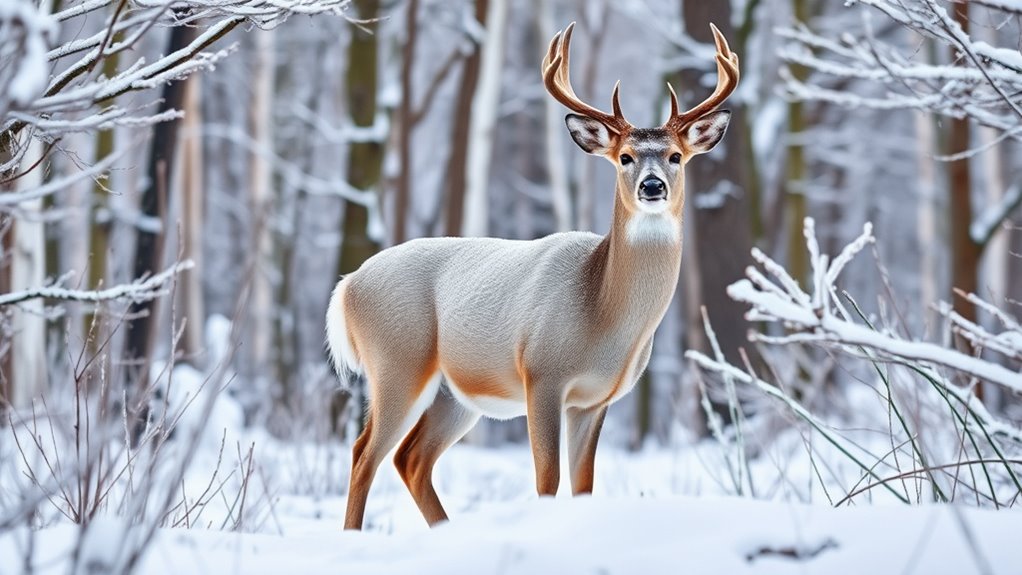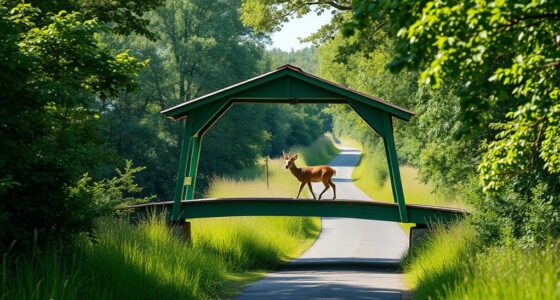To survive winter, deer use several clever adaptations. Their hooves act like snowshoes, helping them move on snow and ice without sinking. They shed antlers to conserve energy and grow a thick, insulating coat to retain warmth. Deer also increase their metabolic rate slightly and seek shelter from the cold. Behaviors like huddling and reducing activity further protect them from harsh conditions. Keep exploring to uncover more about how these adaptations keep deer thriving in winter.
Key Takeaways
- Deer have split hooves that function like snowshoes, aiding movement on snow and icy terrain.
- They grow a dense, insulating winter coat to retain body heat in cold temperatures.
- Deer shed their antlers in winter to conserve energy and nutrients.
- They increase their metabolic rate slightly and reduce activity to generate and conserve heat.
- Behavioral adaptations like sheltering and huddling help deer stay warm and protect against harsh weather.

As winter arrives and food becomes scarce, deer have developed several remarkable adaptations to survive the cold months. One of the most noticeable features is their hoof structure, which plays a pivotal role in maneuvering snowy and icy terrains. Deer’s hooves are split into two symmetrical halves, functioning like natural snowshoes. This design helps distribute their weight more evenly, preventing them from sinking into deep snow and making movement more energy-efficient. When you watch a deer walk across winter landscapes, you’ll notice how their hooves adapt to the challenging conditions, giving them better traction and stability. This structural adaptation is essential because it allows deer to access food sources that might be otherwise unreachable, such as buried shrubs or frozen ground, without wasting excessive energy. Additionally, the hoof structure can also assist in marking territory and aiding in communication among deer through scent dispersal when they paw the ground. The hoof design has evolved specifically to handle the demanding winter environment and can vary slightly among different deer species depending on their habitat.
Another key winter adaptation involves the shedding of antlers. During the colder months, many male deer shed their antlers, which are typically used for mating displays and dominance fights during the rut. As winter progresses, the antlers fall off, a process that conserves energy and nutrients that would otherwise go into maintaining these large, complex structures. You might observe deer with no antlers, especially in late winter, as their bodies shift focus from growth to survival. This shedding process is triggered by hormonal changes that respond to decreasing daylight and temperature. It also signals a shift in the deer’s priorities—from competing for mates to conserving energy and protecting vital body functions during the harsh season.
In addition to hoof adaptations and antler shedding, deer grow a thick winter coat that insulates their bodies from the cold. Their fur becomes dense, trapping air close to the skin, which helps retain body heat. As you observe deer in winter, you’ll see them often huddling or seeking shelter to escape the wind and snow, conserving warmth. Their metabolic rate increases slightly during winter to generate more internal heat, and they often reduce their activity levels to conserve energy. This combination of physical and behavioral adaptations ensures that deer can survive months of scarce food, low temperatures, and challenging conditions. Recognizing these adaptations helps us understand how deer thrive despite the severe winter environment and highlights the importance of their physical features and behaviors for survival.
Frequently Asked Questions
How Do Deer Find Water During Winter Freezing Conditions?
You might wonder how deer find water during freezing winter conditions. They use various water sources like unfrozen streams, ponds, or snow, which they melt for hydration. Deer have strategies to stay hydrated, such as conserving energy and seeking out exposed or sunlit areas where snow melts faster. These hydration strategies help them survive harsh winter conditions, ensuring they stay hydrated even when liquid water seems scarce.
Do Deer Change Their Diet in Winter?
In winter, you’ll notice deer change their diet to include more winter forage like woody browse, twigs, and shrubs. This dietary flexibility helps them find enough nutrients when their usual lush vegetation is scarce. They adapt by browsing on tougher plants, which provides essential calories and nutrients. So, yes, deer do shift their diet during winter, ensuring they survive the cold months despite limited food options.
How Do Young Deer Survive Their First Winter?
You might wonder how young deer, or fawns, survive their first winter. They depend on their mothers for warmth and nourishment, often staying hidden in dense vegetation or snow-covered areas. Fawn nesting and winter sheltering are essential, providing protection from cold and predators. As they grow stronger, they learn to forage and adapt, but initially, their survival hinges on maternal care and choosing the right shelter to stay warm and safe.
Are There Differences in Winter Survival Among Deer Species?
Imagine you’re observing different deer species in winter. You notice that some, like mule deer, migrate south, while others, like white-tailed deer, stay put. These differences in migration patterns affect their survival strategies. Additionally, antler growth slows down in winter, conserving energy. You see how each species adapts uniquely—migration, antler development, and other behaviors—showing that winter survival varies based on their specific adaptations and environmental challenges.
How Do Deer Communicate in Snowy, Quiet Environments?
In snowy, quiet environments, you notice that deer communicate mainly through subtle deer vocalizations and scent marking. You might hear soft grunts or snorts, which serve as alarm signals or social cues. Scent marking plays a crucial role, as you see deer rub their antlers or leave scent trails to establish territory and convey information. This combination helps deer stay connected and alert despite the silence and snow around them.
Conclusion
As winter grips the landscape, your deer friends rely on their remarkable adaptations to survive. Their thick winter coats and efficient fat reserves keep them warm and energized, while their keen senses help find scarce food. Did you know that a deer’s heart rate can drop by up to 50% during hibernation-like periods? This incredible ability conserves energy, proving just how well-equipped they are to endure the cold months ahead. Nature truly crafts resilient creatures like deer to thrive year-round.










